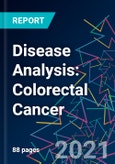Definition
Colorectal (or bowel) cancer refers to carcinomas arising in the epithelium of the large intestine at any point between the cecal valve and the anus. CRC typically develops through the proliferation of mucosal epithelial cells of the gastrointestinal (GI) wall, eventually forming a polyp or adenoma. As with many other cancers of the GI tract, the vast majority (>95%) are adenocarcinomas. Colorectal cancers may be broadly divided between the two major regions of the large intestine. Though some disagreement exists on precisely where the boundary between the colon and the rectum exists, it is generally agreed that a primary tumor < 15cm from the anal margin may be defined as rectum cancer and more distal tumors defined as colon cancer. Though colon cancers are more common than rectal cancers, when considered together, CRC stands as the third deadliest and fourth most diagnosed form of cancer worldwide.
Latest key takeaways
Colorectal (or bowel) cancer refers to carcinomas arising in the epithelium of the large intestine at any point between the cecal valve and the anus. CRC typically develops through the proliferation of mucosal epithelial cells of the gastrointestinal (GI) wall, eventually forming a polyp or adenoma. As with many other cancers of the GI tract, the vast majority (>95%) are adenocarcinomas. Colorectal cancers may be broadly divided between the two major regions of the large intestine. Though some disagreement exists on precisely where the boundary between the colon and the rectum exists, it is generally agreed that a primary tumor < 15cm from the anal margin may be defined as rectum cancer and more distal tumors defined as colon cancer. Though colon cancers are more common than rectal cancers, when considered together, CRC stands as the third deadliest and fourth most diagnosed form of cancer worldwide.
Latest key takeaways
- The publisher estimates that in 2018, there were 1.80 million incident cases of colorectal cancer (CRC) worldwide, and expects that number to increase to 1.95 million incident cases by 2027.
- CRC may be subdivided into two distinct categories based on the anatomical origin of the primary tumor - rectal cancer and colon cancer.
- The majority of CRC diagnoses (60.9%) worldwide are colon cancer, ranging from 57.3% to 68.5% across regions.
- Colon cancer is fairly evenly distributed between sexes, with males accounting for 52.5% of global colon cancer diagnoses in 2018, whereas rectum cancer is more common among men, who made up 61.0% of diagnoses in 2018.
- Although systemic therapy is administered in locoregional disease, typically as adjuvant treatment, such regimens consist of genericized chemotherapies. All branded agents are confined to metastatic, unresectable CRC.
- Conventional targeted treatments in CRC are angiogenesis inhibitors typically acting through the receptor tyrosine kinase (RTK) superfamily, including EGFR antagonists, such as Erbitux and Vectibix, and VEGFR antagonists, such as Cyramza, Zaltrap, and Avastin (the latter two inhibit VEGFR through its ligand, VEGF). Additionally, Stivarga is a polyspecific tyrosine kinase inhibitor (TKI) simultaneously targeting VEGFR, PDGFR, and EGFR in addition to non-tyrosine kinases c-KIT and RAF.
- Treatment for mCRC is heavily dependent on gene expression, with many drugs being prescribed only for specific tumor profiles.
- First- and particularly second-line metastatic CRC have become very crowded treatment settings, with multiple combinations of chemotherapies and targeted agents competing for the same patient subsets.
- Avastin, the first targeted agent launched in the indication, is the traditional standard of care and remains widely prescribed in both first- and second-line disease and across tumor profiles. However, the branded drug is approaching the end of its lifecycle and the recent launch of bevacizumab biosimilars will significantly erode its market share.
- Despite biosimilar erosion of branded Avastin, bevacizumab’s potential incorporation into new, highly active combination therapies in first- and second-line mCRC stands to cement the drug’s status as a standard of care.
- Tumors that are RAS/BRAF WT and EGFR+ are among the most common gene expression profiles, accounting for approximately 40% of CRCs. The EGFR antagonist Erbitux, among the first targeted agents launched in CRC alongside Avastin, remains the most commonly prescribed therapy for this subset of patients, despite the more recent addition of Vectibix in the same setting.
- Erbitux has recently found a new use in a doublet with the RAF kinase inhibitor Braftovi for BRAF V600E mutants. The combination is highly active, but only 12-15% of CRCs are BRAF V600E+ and the regimen is currently confined to second-line use.
- Anti-PD-1 checkpoint inhibitors Opdivo and Keytruda have seen initial success in microsatellite instability-high/defective mismatch repair (MSI-H/dMMR) mCRCs, although these comprise only 15% of patients.
- The exploratory CheckMate 9X8 regimen of bevacizumab, Opdivo, and FOLFOX in front-line disease, currently in Phase II/III investigation, has the potential to both introduce a highly active combination to the CRC treatment landscape and also expand PD-1 inhibitor use to the wider patient population who are MSI normal/MMR proficient.
- A suite of trial suspensions has shrunk the late-stage CRC pipeline. Current Phase III drugs include the MEK inhibitor Mektovi, the CDK antagonist Cosela, the novel folate Modufolin, the PARP inhibitor Lynparza, and the novel VEGFR inhibitor fruquintinib.
Table of Contents
OVERVIEW
DISEASE BACKGROUND
TREATMENT
EPIDEMIOLOGY
KEY REGULATORY EVENTS
LICENSING AND ASSET ACQUISITION DEALS
CLINICAL TRIAL LANDSCAPE
FUTURE TRENDS
RECENT EVENTS AND ANALYST OPINION
LIST OF FIGURES
LIST OF TABLES








